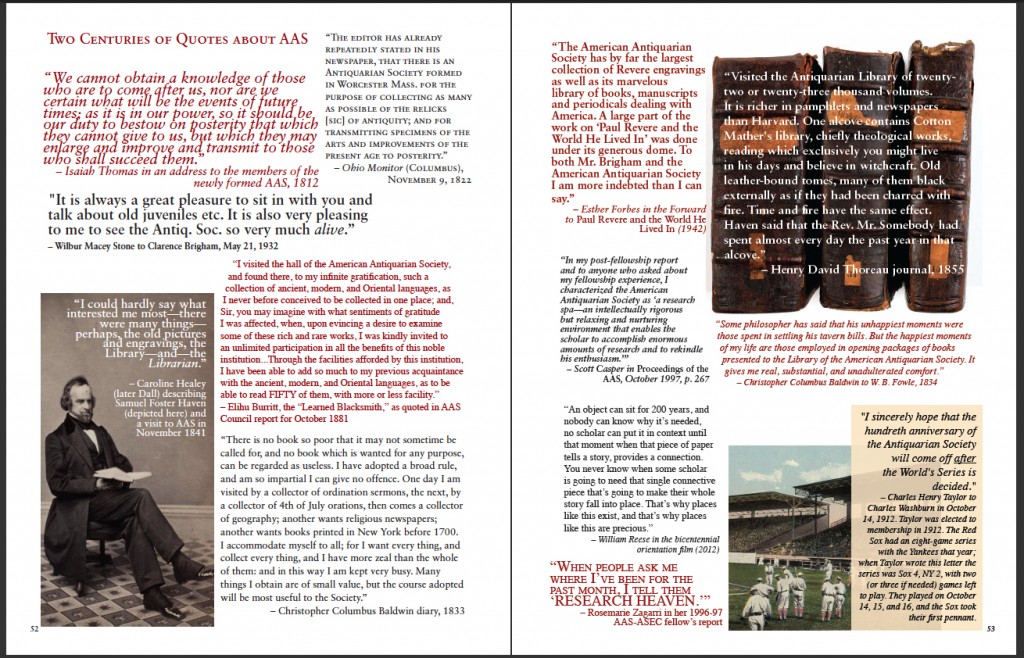 Another year done means another Annual Report. For most, the phrase “annual report” doesn’t exactly elicit imaginings of stimulating reading material. But here at AAS we like to think of the Annual Report as more than just a business reckoning. It’s also a reflection of a thriving community—a learned society, if you will—made up of diverse individuals which offers a wide range of resources, events, exhibitions, and seminars. So if you look beyond, and even to, the numbers, lists, and recaps of the year, you’ll see a much more interesting story take shape, one in which the Society is growing and flourishing as it enters its third century.
Another year done means another Annual Report. For most, the phrase “annual report” doesn’t exactly elicit imaginings of stimulating reading material. But here at AAS we like to think of the Annual Report as more than just a business reckoning. It’s also a reflection of a thriving community—a learned society, if you will—made up of diverse individuals which offers a wide range of resources, events, exhibitions, and seminars. So if you look beyond, and even to, the numbers, lists, and recaps of the year, you’ll see a much more interesting story take shape, one in which the Society is growing and flourishing as it enters its third century.
That’s why we’ve decided to share with you some of our favorite parts of this year’s Annual Report (September 2012 – August 2013), now available in print and online.
- The covers! Almost every printing job gives us the chance to show off a physical book history element. For this issue of the Annual Report, we inverted the idea of endpapers and placed them on the outside of the text rather than the inside, to almost bookend the events of the 2012-2013 year. The example we show here is a marbled sample from a copy of Isaiah Thomas’s 1810 The History of Printing in America. The endpapers were pasted to the board covers and first leaf to secure the binding of the volume. It’s not that we disapprove of securing the binding of the Annual Report—we just want you to dive right in and read it cover to unprotected cover. On the back cover over the endpapers is the bookplate of Isaiah Thomas that was engraved by Paul Revere in 1769. There was a lively debate about which version of Thomas’s bookplate to use, State I or State II. Annual Report 2013 challenge: figure out which one we used.
- The several pages covering bicentennial events. Although the bicentennial now seems ages ago, this provided the perfect opportunity to reflect one more time on what was an extremely busy but extremely successful autumn in 2012. From the vintage dancers at the Black and White and Read All Over gala, to the many appearances of Isaiah Thomas, to the Grolier Club exhibition in New York, the celebrations raged on!
- The recent acquisitions. In pursuit of our mission to “collect, preserve, and make available for study” the printed record of what is now the United States through 1876, we are continually acquiring new items through purchase or gift. (If you’re curious to know more about our acquisitions process, check out the feature article in the latest issue of the Almanac.) Although there are too many to feature them all, we picked a few that illustrate the breadth and rarity of the collections. Among them is the only known copy of a 1788 broadside about a double hanging in western Massachusetts related to Shays’s Rebellion; a bound volume of six early American pamphlets, five of which we did not yet hold in our collections; an 1886 McLoughlin Bros. three-dimensional panorama book featuring a farmer, a parrot, and an elephant; and yet another addition to our quickly-growing collection of the various editions of Audubon—a plate from the original elephant-sized folio edition of Birds of America. Not too shabby!
- The “In Memoriam” section. At first glance this may seem like a strange choice, especially given what a sad year it was for AAS membership—we lost twenty-four members, almost twice as many as last year, and many of them close friends and staunch supporters of the Society. But this is also what makes this section so rich. As a whole, it provides a captivating look at a cross-section of our membership, and serves as a reminder of how lucky we are to count such fascinating and illustrious people as part of our community. They include prestigious historians, local businessmen and philanthropists, former staff members, dedicated researchers and writers, and many, many World War II veterans. We are pleased to have the opportunity to mourn, honor, and celebrate them all.
 And finally, “Two Centuries of Quotes about AAS”! With two hundred years of fodder, we were sure to find some gems. Read these to find out who had a crush on one of our nineteenth-century librarians, what Henry David Thoreau thought about his visit in 1855, and what the Red Sox have to do with our centennial. This was also a section where, graphically speaking, we could let our hair down. Throughout the rest of the text we kept to Sabon 18-Point Bold Small Caps. Here you’ll see, well, we lost all control.
And finally, “Two Centuries of Quotes about AAS”! With two hundred years of fodder, we were sure to find some gems. Read these to find out who had a crush on one of our nineteenth-century librarians, what Henry David Thoreau thought about his visit in 1855, and what the Red Sox have to do with our centennial. This was also a section where, graphically speaking, we could let our hair down. Throughout the rest of the text we kept to Sabon 18-Point Bold Small Caps. Here you’ll see, well, we lost all control.
See? The Annual Report really is not all business. We could keep going on and on with the nuts and bolts, but then this post could be 56 pages long. So at this point, you might as well just read the Annual Report.


